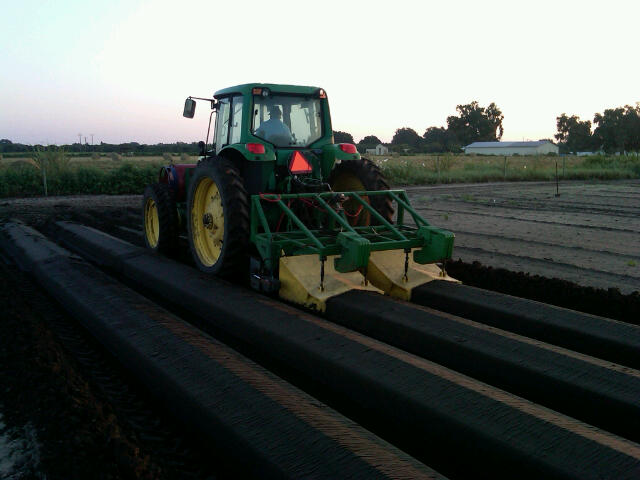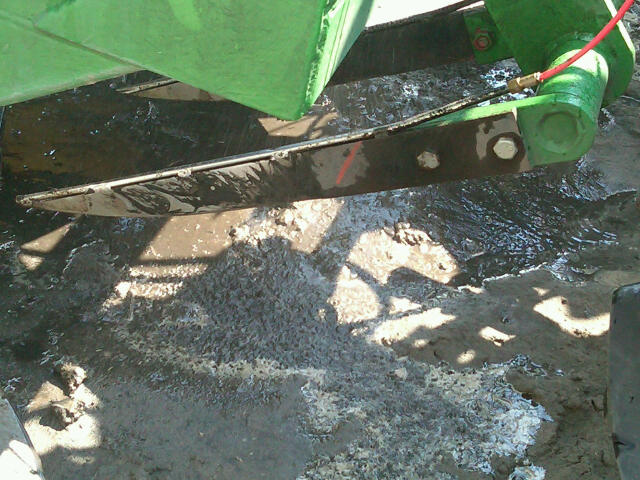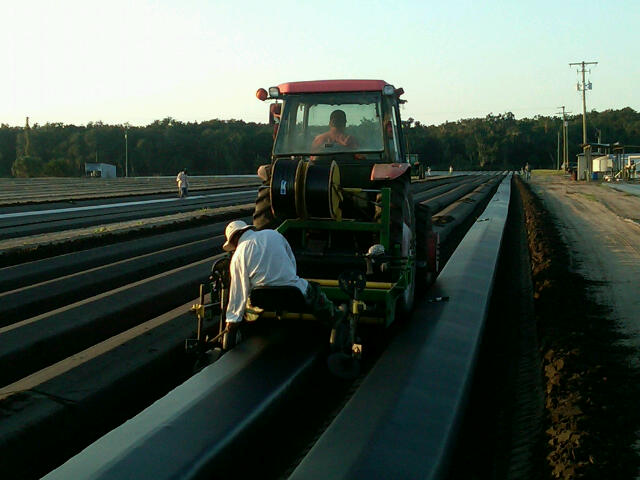









Click any image for a larger view and please note that all farms are not the same, so the practices outlined may be different at other locations.

 Plastic laying all starts with the bed press (far right). The tractor pulls down a row with the press, forming the dirt into a shape we are commonly used to. At the same time the row is being made, the knife (right) is putting any fumigant used out into the soil. If you click on the knife picture to enlarge it, you will see that there is a small metal tube attached to a red hose. That is the tube the fumigant comes out of. Fumigants are used to sterlilize the soil of any grasses, weeds or pests that could interfere with normal strawberry plant growth. An overabundance of weeds or pests will inhibit production greatly throughout a strawberry season. Now, once down a row is not enough. The tractor has to go down a row a second time to smooth the bed out for the plastic laying machine. The whole process is slow as well, with a tractor generally only travelling at 3-5 mph all day long.
Plastic laying all starts with the bed press (far right). The tractor pulls down a row with the press, forming the dirt into a shape we are commonly used to. At the same time the row is being made, the knife (right) is putting any fumigant used out into the soil. If you click on the knife picture to enlarge it, you will see that there is a small metal tube attached to a red hose. That is the tube the fumigant comes out of. Fumigants are used to sterlilize the soil of any grasses, weeds or pests that could interfere with normal strawberry plant growth. An overabundance of weeds or pests will inhibit production greatly throughout a strawberry season. Now, once down a row is not enough. The tractor has to go down a row a second time to smooth the bed out for the plastic laying machine. The whole process is slow as well, with a tractor generally only travelling at 3-5 mph all day long.
 With the bed made, it's now time to put the plastic over the dirt. As you can see, the machine (pictured left) fits right over the bed and rolls down the row to make a smooth layer of plastic to cover the mound created by the bed press. As the roll of plastic is unwinding, the two small discs behind the wheels are spinning and shooting dirt to cover the plastic on the side of the beds. The plastic machine takes much more management during the process than the bed press. We're constantly tweaking the angle the machine lays the plastic to make sure the plastic is firm against the bed. Loose plastic + wind is a bad combination and we would have to spend thousands of dollars to fix rows of plastic flapping in the breeze.
With the bed made, it's now time to put the plastic over the dirt. As you can see, the machine (pictured left) fits right over the bed and rolls down the row to make a smooth layer of plastic to cover the mound created by the bed press. As the roll of plastic is unwinding, the two small discs behind the wheels are spinning and shooting dirt to cover the plastic on the side of the beds. The plastic machine takes much more management during the process than the bed press. We're constantly tweaking the angle the machine lays the plastic to make sure the plastic is firm against the bed. Loose plastic + wind is a bad combination and we would have to spend thousands of dollars to fix rows of plastic flapping in the breeze. The plastic machine also serves the dual purpose of laying the drip irrigation tape under the plastic at the same time that the plastic is being put down on the bed. You'll need to enlarge the photo on the right to see the process as it is explained here. Under the yellow circular bar is a square solid piece of tubing. That square tube creates a trench right in the top of the bed of dirt down the entire row. Just above the yellow circular bar is a hollow tube the drip irrigation tape resides in. In one magical motion, as the trench is created in the dirt, the drip tape follows right behind it and lays down perfectly in the trench. If the tube does not go right into the trench, any wind will blow the drip tube everywhere and you will see a snake-like pattern under the plastic that has to be fixed. This whole process is occurring milliseconds before the plastic is laid on top of it. It seems so simple, yet the complexity of the machine performing so many functions means any misstep is a huge headache for the farm.
The plastic machine also serves the dual purpose of laying the drip irrigation tape under the plastic at the same time that the plastic is being put down on the bed. You'll need to enlarge the photo on the right to see the process as it is explained here. Under the yellow circular bar is a square solid piece of tubing. That square tube creates a trench right in the top of the bed of dirt down the entire row. Just above the yellow circular bar is a hollow tube the drip irrigation tape resides in. In one magical motion, as the trench is created in the dirt, the drip tape follows right behind it and lays down perfectly in the trench. If the tube does not go right into the trench, any wind will blow the drip tube everywhere and you will see a snake-like pattern under the plastic that has to be fixed. This whole process is occurring milliseconds before the plastic is laid on top of it. It seems so simple, yet the complexity of the machine performing so many functions means any misstep is a huge headache for the farm.  So let's summarize how the plastic is put down. A bed press goes down the row, creating a mound of dirt and injecting any fumigants used. The bed press then goes back down the same row again to smooth the bed out. The plastic laying machine follows on the row just made by the bed press. That machine not only puts the plastic down firmly on the bed, but it creates a trench and places the drip tube under the plastic at the same time. If all goes well, you've got a pretty picture like the one on the left to enjoy the fruits of a hard day at work. If we work all day at it, we could lay 10 acres of plastic as long as all the machines cooperate. The next installment will be connecting the drip irrigation up so that we can get water flowing to the beds under the plastic. If you ever have any questions about how the farm operates, we're always available via e-mail at spiveyfarms@gmail.com
So let's summarize how the plastic is put down. A bed press goes down the row, creating a mound of dirt and injecting any fumigants used. The bed press then goes back down the same row again to smooth the bed out. The plastic laying machine follows on the row just made by the bed press. That machine not only puts the plastic down firmly on the bed, but it creates a trench and places the drip tube under the plastic at the same time. If all goes well, you've got a pretty picture like the one on the left to enjoy the fruits of a hard day at work. If we work all day at it, we could lay 10 acres of plastic as long as all the machines cooperate. The next installment will be connecting the drip irrigation up so that we can get water flowing to the beds under the plastic. If you ever have any questions about how the farm operates, we're always available via e-mail at spiveyfarms@gmail.com
